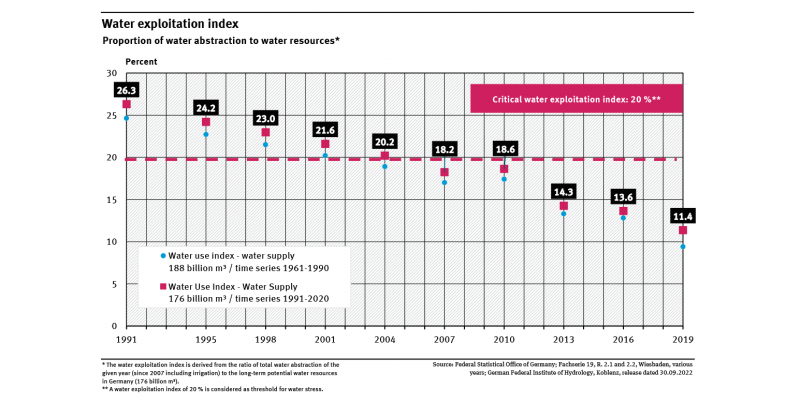Table of Contents
Water is a vital and limited resource. There are legal provisions on its sustainable management, designed to protect waterbodies
- as an element of the ecosystem
- as a basic necessity for human life
- as a habitat for animals and plants
- as a usable commodity.
The tasks of water resource management are manifold and diverse, and the regulatory framework is equally extensive.
Available water resources and water usage
With potential available water resources of 188 billion cubic metres, Germany is a country rich in water resources. In 2016, a total volume of 24 billion m³ water was abstracted in Germany.
The largest volume of water was abstracted by energy suppliers at 12.7 billion m³ (52.9 % of total abstractions). The public water supply which supplies households and small businesses with drinking water only utilised 5.2 billion m³ (21.7 % of total abstractions). The mining and manufacturing industries abstracted 5.8 billion m³ (24.2 % of total abstractions). Only 0.3 billion m³ (1.3 % of total abstractions) was attributable to agricultural irrigation. Over the past 20 years, there has been a clear reduction in the volume of water abstraction across all sectors. In 2016 only 12,8 % of Germany’s potential available water resources were used.

Source: Federal Statistical Office of Germany Figure as PDF
Individual water use
Almost all households and public institutions as schools or hospitals in Germany are connected to the public water supply; i.e. all citizens have access to perfect drinking water all times. Between 1991 and 2013 the drinking water use declined by about 15 % due to water saving household- and sanitation technologies, information and awareness raising among citizens as well as due to a water tariff that is largely consumption dependent. In 2016, 123 litre were used per person per day.
Legal Framework
Since 2000 the Water Framework Directive WFD) has been the central instrument for water resource management. Its broad-based approach includes the protection of inland surface waters, transitional waters, coastal waters and groundwater. Its principal aim is to ensure a good status of all waterbodies within the EU. This implies improving aquatic ecosystems while any further deterioration is prohibited. The WFD is supplemented by its “daughter” directives (Groundwater Directive, Environmental Quality Standards Directive). Other water related key directives include among others the Marine Strategy Framework Directive, the Flood Risk Management Directive, the Industrial Emissions Directive and the Urban Waste Water Treatment Directive. Germany has fully transposed the requirements of these directives to national legislation through its Federal Water Act and corresponding ordinances.
Water status assessment
The Water Framework Directive requires from all Member States to assess the ecological and chemical status of its surface waters as well as the quantitative and chemical status of groundwater bodies. The assessment is based on different quality elements. Environmental quality standards have been set up for relevant pollutants in surface water and groundwater.
Surface waters
Many of Germany’s surface waterbodies have not yet reached good ecological status. The result reflects the high intensity of use of Germany’s waterbodies and their catchments, e.g. by agriculture, industry, shipping or power generation. Only 8.2 % of around 9,800 waterbodies are currently in “high” or “good ecological status”.
The German Länder (federal states) assessed all surface waters to be failing to achieve good chemical status. This is mainly due to the fact that the Environmental Quality Standard (EQS) for mercury is not met. The EQS is set to appropriately protect all aquatic species from algae up to animals that are feeding on fish.
Groundwater
95.7 % of around 1,180 assessed groundwater bodies are in a good quantitative status, and 63.7 % are in a good chemical status. The main reason for a poor chemical status (36 %) is non-point pollution with nitrate (27.1 % of groundwater bodies exceed the EQS of 50 mg/l) and with pesticides (2.8 % of groundwater bodies exceed the EQS of 0.1 μg/l) from agriculture.
Current developments
National Water Strategy
On 8 June 2021 the Federal Environment Ministry presented the “National Water Strategy”. It addresses questions related to securing the supply of high-quality water for humans and the environment by 2050. The draft for the "National Water Strategy" is based on results of a two-year National Water Dialogue that the ministry had implemented together with UBA. More than 200 participants from the water industry, agriculture and research, from associations, federal states and municipalities contributed in the stakeholder dialogue.
Trace Substance Strategy
Since 2016 a multi-stakeholder dialogue has been in place to establish a Trace Substance Strategy of the Federal Government, professionally managed by Fraunhofer ISI and moderated by IKU GmbH. In its first phase it resulted in a policy paper with “Recommendations from the Muliti-Stakeholder Dialogue on the Trace Substance Strategy of the German Federal Government” (2017). In the following phases the recommendations were followed-up with more precise activities that were then piloted in 2019/2020. This included the establishment of an expert panel to select relevant trace substances on the basis of an agreed procedure, the setting up of round tables (x-ray contrast agents, diclofenac and benzotriazole) to identify targeted reduction measures, a common communication strategy under the UN-Water Decade as well as a guiding framework for the extension of urban waste water treatment plants (“fourth tratement stage”) and resulted in the establishment of a new Federal Centre for Trace Substances at UBA.
In 2018 UBA had published “Recommendations for reducing micropollutants in waters” proposing a combination of measures at the source, in use and for wastewater treatment.

